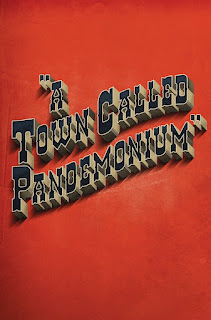(December 2012)
Well, it was inevitable really. The 21st
Century has finally clawed its way into Kamo Manors and I ended up with a
kindle for christmas. I promptly downloaded half a dozen books in various
promotions and giveaways. So not a problem cashwise, but I’m not exactly short
of stuff waiting to be read as it is. This can only end badly.
They're TV shows though, and the trouble is that as far as books go I’m not big
on Westerns. I read Blood Meridian and The
Sisters Brothers last year but before that I’m not sure. Westworld maybe. True History of the Kelly Gang probably doesn’t qualify simply though geography, though
it’s certainly in the right spirit, so I’ve really got nothing else.
Lots of stuff to like here though. Favourites
include Rhod the Killer (by Sam Wilson),
a tightly wound little farce with a wonderful payoff line. Grit (Scott K. Andrews) has real teeth and a protagonist who
remains bollock-naked throughout, which makes for a diverting if not entirely pleasant
reading experience, though obviously that very much depends on what floats
your own personal boat. With 4.25 to
Pandemonium Archie Black again demonstrates an ability to give her
characters distinctive, captivating voices that makes Peter Carey look like a
drunk ventriloquist in an end-of-the-pier variety show during the off-season.
The final story from Osgood Vance (Sleep
in Fire) is a brutally appropriate way to wrap it all up.
The real strength of Town… is the way it works together as a whole. This is a fully realized
world that the various authors and editors have brought about from nothing. The
best example of this is Den Patrick’s Red
Hot Hate. Your first thought on reading it is that it's probably the weakest story here. It’s well
written but in this company feels a little slight; when it finishes you’re left with a sense
of, ‘Oh. That’s it then?’
However, when all's said and done you get the distinct impression
that the author has taken one for the team, because what it initially seems to lack in
individual clout it more than makes up for in embedding itself in the town and
the town in your imagination. Characters and situations from one story
continually appear in others (the luckless Silver Dollar saloon reaching almost
Kenny-esqe levels of misfortune). Red Hot
Hate brings a lot of these together, and as the penultimate tale this
really allows Sleep in Fire to shine
as you feel more fully invested in the town and its fate.
This collection feels like it didn’t have
editors so much as curators. As impressive as some of the individual stories
are, they way they hang together as a single work is even more so. Little Kindy
couldn’t have wished for a better christening present. Yee-haw.

Awesome, thank you! (That'll teach that Peter Carey a lesson!)
ReplyDeleteYou're most welcome.
DeleteIt's not so much that I think Peter Carey is bad (though while I loved True History..., I did give the last book I read of his a bit of a kicking), so much as it's I'm increasingly a fan of Ms Black.
Thanks for stopping by, and keep up the good work!